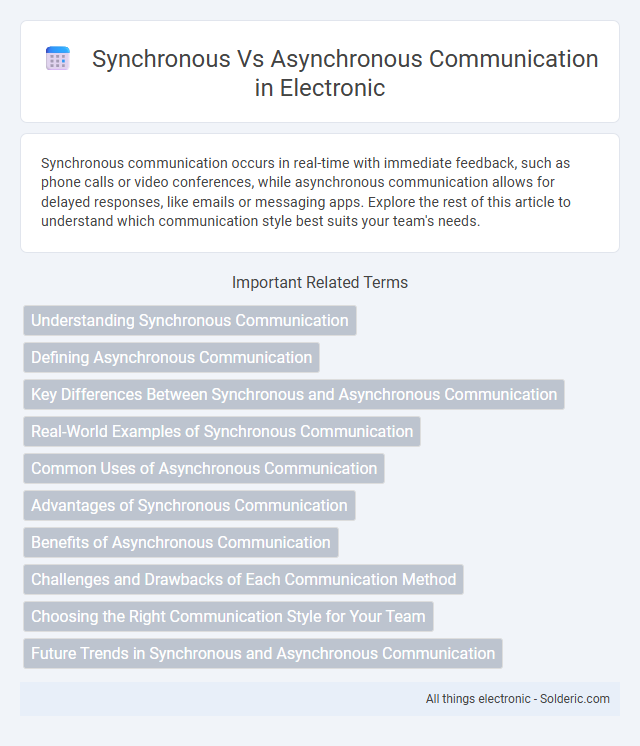Synchronous communication occurs in real-time with immediate feedback, such as phone calls or video conferences, while asynchronous communication allows for delayed responses, like emails or messaging apps. Explore the rest of this article to understand which communication style best suits your team's needs.
Comparison Table
| Feature | Synchronous Communication | Asynchronous Communication |
|---|---|---|
| Definition | Real-time exchange of information between participants | Time-independent exchange where responses occur with delays |
| Examples | Phone calls, video conferences, live chats | Email, forums, recorded messages |
| Response Time | Immediate or near-immediate | Delayed; depends on user availability |
| Interaction | Requires all parties to be present simultaneously | Allows participants to contribute at different times |
| Advantages | Faster decision-making; instant feedback; better clarity | Flexibility; time for thoughtful responses; better for complex topics |
| Disadvantages | Scheduling challenges; interruptions; pressure to respond quickly | Slower communication; possible misinterpretations; requires self-discipline |
| Use Cases | Meetings, troubleshooting, brainstorming sessions | Project updates, documentation, remote team collaboration |
Understanding Synchronous Communication
Synchronous communication occurs in real-time, enabling immediate interaction and feedback between participants through mediums like phone calls, video conferences, or face-to-face meetings. This form of communication is essential for collaborative tasks requiring quick decision-making and dynamic exchange of ideas. Understanding synchronous communication helps organizations optimize workflows by enhancing responsiveness and reducing delays in information exchange.
Defining Asynchronous Communication
Asynchronous communication allows messages to be sent and received without requiring all participants to be engaged simultaneously, enabling flexibility in response times. Common forms include emails, instant messaging, and forums, which support dynamic workflows and accommodate different time zones. This method enhances productivity by letting you manage interactions according to your schedule, reducing interruptions and improving focus.
Key Differences Between Synchronous and Asynchronous Communication
Synchronous communication occurs in real-time, requiring all participants to be present simultaneously, such as in phone calls or video conferences, enabling immediate feedback and dynamic interactions. Asynchronous communication happens with time delays, allowing recipients to respond at their convenience through emails or messaging platforms, enhancing flexibility and thoughtful responses. Understanding these key differences can help you select the most effective communication method for your team's needs and workflow.
Real-World Examples of Synchronous Communication
Real-world examples of synchronous communication include face-to-face meetings, phone calls, video conferences, and live chat interactions where participants exchange information in real-time. These methods facilitate instant feedback, making them ideal for collaborative decision-making and immediate problem-solving. Synchronous communication is commonly used in corporate team meetings, customer support calls, and virtual classrooms.
Common Uses of Asynchronous Communication
Asynchronous communication is commonly used in email exchanges, messaging platforms like Slack, and project management tools such as Trello or Asana, enabling team members to share updates without requiring immediate responses. It supports remote work environments by allowing flexibility across different time zones and reduces interruptions by letting individuals respond at their own pace. Asynchronous communication is essential for documentation purposes, brainstorming sessions, and long-term collaborative projects where thoughtful input and record-keeping are critical.
Advantages of Synchronous Communication
Synchronous communication allows real-time, immediate interactions that enhance collaboration and decision-making efficiency, making it ideal for urgent matters or complex discussions. It fosters clear understanding through instant feedback, reducing misunderstandings and increasing team alignment. Your team benefits from faster problem-solving and a more dynamic exchange of ideas during synchronous meetings or calls.
Benefits of Asynchronous Communication
Asynchronous communication enhances flexibility by allowing participants to respond at their convenience, improving productivity and reducing interruptions. It supports global teams across different time zones by eliminating the need for real-time interaction, facilitating smoother collaboration. This method also provides a written record of conversations, ensuring clarity and accountability in discussions.
Challenges and Drawbacks of Each Communication Method
Synchronous communication demands real-time interaction, which can lead to scheduling conflicts and interrupt workflow, reducing productivity. Asynchronous communication may cause delays in response time and misunderstandings due to lack of immediate feedback, impacting project timelines. Your choice between these methods should consider the balance between immediacy and flexibility to mitigate their inherent drawbacks.
Choosing the Right Communication Style for Your Team
Selecting the appropriate communication style depends on your team's goals and work environment. Synchronous communication, such as video calls and live chats, enhances real-time collaboration and quick decision-making, ideal for urgent tasks or brainstorming sessions. Asynchronous communication methods, including emails and project management tools, provide flexibility and allow team members to process information at their own pace, supporting remote and distributed teams effectively.
Future Trends in Synchronous and Asynchronous Communication
Future trends in synchronous communication emphasize enhanced real-time collaboration tools powered by AI-driven features such as automated transcription, sentiment analysis, and adaptive bandwidth optimization, improving the efficiency of virtual meetings. Asynchronous communication is evolving with advanced AI integrations for intelligent message prioritization, context-aware notifications, and seamless multi-platform synchronization, enabling more flexible and productive workflows. The convergence of synchronous and asynchronous methods through hybrid communication systems is expected to create more dynamic, responsive, and inclusive work environments.
Synchronous vs Asynchronous communication Infographic

 solderic.com
solderic.com